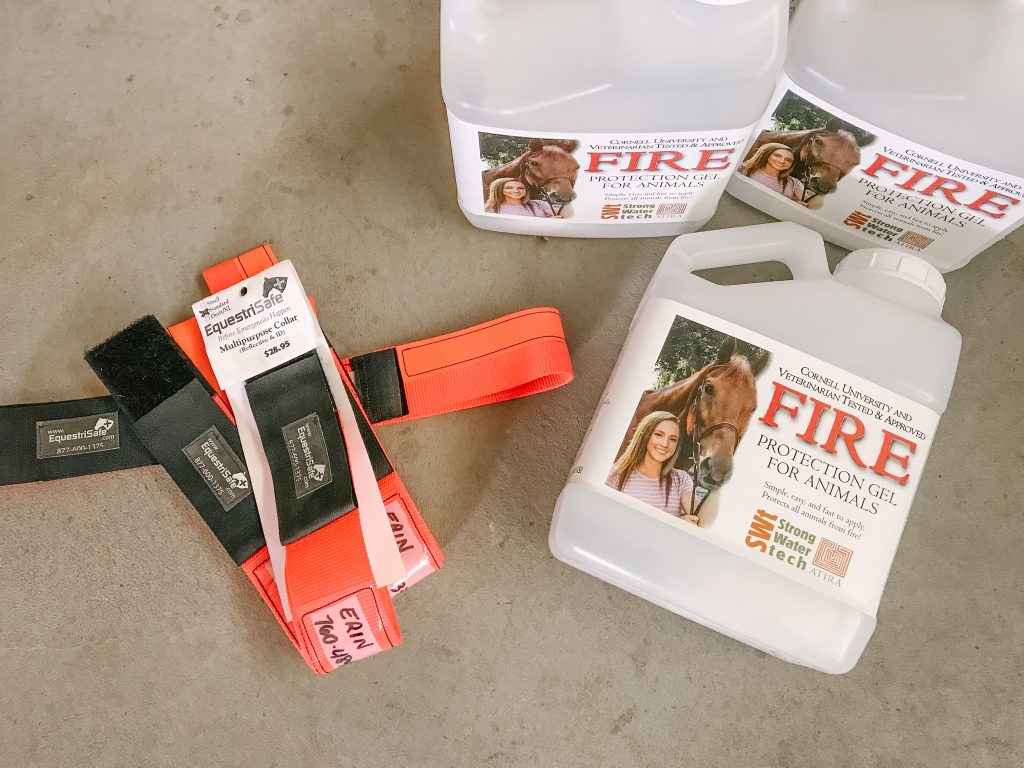A topic that we don’t want to think about but in some parts of the country is necessary.
This hits close to home having grown up in California where brush fires were the norm and in 2007 my two horses survived the Witch Fire in San Diego.
My trainer was evacuating a load of horses from Ramona to Del Mar and the fire was spreading so quickly the roads were closing behind her. Eight horses were left behind including my two boys. Luckily, my trainer had removed brush and maintained a defensible space. The firefighters, upon arrival, knew they could work to defend and save her property. I’ve been told by our local fire captain that if they arrive at a property that they cannot save they’ll move on to the next.
There are two scenarios with fires and owning horses…your horses will be evacuated OR your horses will not be evacuated. I prepare for both cases.
Here are some things that I have done in case of a fire in my area. You can never be too prepared!
Defensible Space
You can start at home with defensible space. Call your local fire department and a Fire Captain is more than happy to visit your property and tell you what you can do to make it defendable. I spend a lot of time mowing and weed-whacking weeds and grasses to keep them short. I have also removed sagebrush within 30+ feet of our home and barn. I keep the outdoor horse turnouts free of weeds so they have a large safe area to be loose in case they cannot be evacuated. Also, make sure your property is accessible to firefighters and their trucks.
Horse Records
Keep copies of important records…ownership records, breed registration papers, brand inspection, bill of sale, insurance paperwork, microchip, health records, etc.
Keep photos of brands, and photos of you and your horse.
All of these items can be saved on a thumb drive or be accessed on your phone, iCloud.
Food and Water
In case my horse are on the property during a fire, I keep my water troughs topped off every day. I know they will have enough water for 3 days. Automatic waterers may be damaged in a fire and may not work to supply water so you may want to use troughs as a backup.
I also keep full water containers and hay in my horse trailer. I have stored enough food and water for 3 days.
Another great thing to have on hand is Thirst Quencher to aid in water consumption during stressful times and to promote drinking in new places where water may taste different.
Evacuation
Practice with horses often to ensure that they will load in the trailer quickly. Review your to-do list monthly so it can be completed in a timely fashion.
Non-evacuation
I may not be home when a fire starts nearby and may not be able to evacuate my horses. I keep a list and box of supplies in my barn so I can have someone else help out during a fire.
- Put halters on. (My halters are leather so they won’t melt in heat and will break in case they get caught up but when left on they will make catching a horse later easier if turned loose.)
- Put ID collar on. (I have collars from EquestriSafe and have my name and phone number attached. These ID collars are also great for horses to wear when at the evacuation site.)
- Cover each horse with Atira SWT Fire Safety Gel (Safety Gel is from Mary’s Tack. The safety gel is applied to each horse and lasts 6-8 hours and reduces the risk of steam and fire burns.)
Hopefully, you will never have to experience a fire with your horses, but there is a sense of calm when you know that you have done everything you can to be prepared.
**
Erin Gouveia of Silver Oaks Farm is an accomplished equestrian, award winning photographer, and an artist. She was born and raised in San Diego, California, graduated from Colorado State University, and now resides in Park City, Utah on a small ranch with her husband. She has had careers in Medical Research, Zookeeping, and most currently Photographer at Erin Kate Photography.
Follow Erin on Instagram at @silveroaksfarm and find her equestrian inspired fine art photographs and handmade goods in her Etsy shop SilverOaksFarm.




